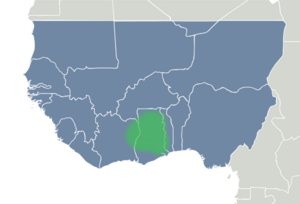
Back مجمع كينتامبو Arabic Kintampo-Kultur German Complexe de Kintampo French キンタンポ文化 Japanese Kintampo (stanowisko archeologiczne) Polish Кинтампо Russian

The Kintampo complex, also known as the Kintampo culture, Kintampo Neolithic, and Kintampo Tradition, was established by Saharan agropastoralists, who may have been Niger-Congo or Nilo-Saharan speakers and were distinct from the earlier residing Punpun foragers,[1] between 2500 BCE and 1400 BCE.[2] The Kintampo complex was a part of a transitory period in the prehistory of West Africa, from pastoralism to sedentism in West Africa, specifically in the Bono East region of Ghana,[3][1] eastern Ivory Coast, and Togo.[1] The Kintampo complex also featured art, personal adornment items, polished stone beads, bracelets, and figurines; additionally, stone tools (e.g., hand axes) and structures (e.g., building foundations) were found, which suggests that Kintampo people had both a complex society and were skilled with Later Stone Age technologies.[4]
- ^ a b c Cite error: The named reference
Watsonwas invoked but never defined (see the help page). - ^ Ness, Immanuel (Nov 10, 2014). "Sub-Saharan Africa: Archaeology". The Global Prehistory of Human Migration. Wiley Blackwell. p. 110. ISBN 9781118970591. OCLC 890071926. S2CID 160957067.
- ^ Casey, Joanna (2000). The Kintampo Complex: The Late Holocene on the Gambaga Escarpment, Northern Ghana. Archaeopress. ISBN 978-1-84171-202-4.
- ^ Anquandah, James (1995) The Kintampo Complex: a case study of early sedentism and food production in sub-Sahelian west Africa, pp. 255–259 in Shaw, Thurstan, Andah, Bassey W and Sinclair, Paul (1995). The Archaeology of Africa: Food, Metals and Towns. London: Routledge. ISBN 0-415-11585-X
© MMXXIII Rich X Search. We shall prevail. All rights reserved. Rich X Search